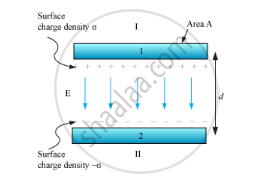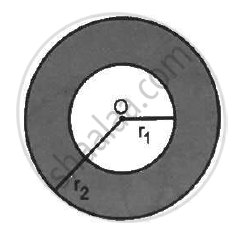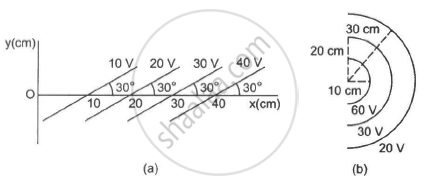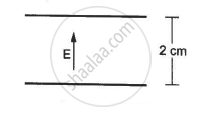Advertisements
Advertisements
प्रश्न
(i) If two similar large plates, each of area A having surface charge densities +σ and –σ are separated by a distance d in air, find the expressions for
(a) field at points between the two plates and on outer side of the plates. Specify the direction of the field in each case.
(b) the potential difference between the plates.
(c) the capacitance of the capacitor so formed.
(ii) Two metallic spheres of Radii R and 2R are charged so that both of these have same surface charge density σ. If they are connected to each other with a conducting wire, inn which direction will the charge flow and why?
उत्तर
(a)
We are given two similar large plates separated by a small distance (d) and having area (A).

Surface charge density of plate 1, σ = Q/A, and that of plate 2 is − σ.
Electric field in different regions:
Outer region I,
`E=sigma/(2epsilon_0)-sigma/(2epsilon_0)=0`
Outer region II,
`E=sigma/(2epsilon_0)-sigma/(2epsilon_0)=0`
In the inner region between plates 1 and 2, the electric fields due to the two charged plates add up. So,
`E=sigma/(2epsilon_0)+sigma/(2epsilon_0)=sigma/epsilon_0=Q/(epsilon_0A)`
The direction of electric field is from the positive to the negative plate.
(b)
For uniform electric field, potential difference is simply the electric field multiplied by the distance between the plates, i.e.
`V=Ed=1/epsilon_0 (Qd)/A`
(c)
Capacitance C of the parallel plate capacitor,
`C=Q/V=(epsilon_0A)/d`
(ii)
We know that the potential of the metallic sphere is given by,
`V=Q/(4piepsilon_0r) `
Now, the potential of the metallic sphere of radius R is given by,
`V_R=Q/(4piepsilon_0R)`
`V_R=(sigma(4piR^2))/(4piepsilon_0R)`
`V_R=(sigmaR)/epsilon_0`
Similarly, the potential of the metallic sphere of radius 2R is given b
`V_(2R)=Q/(4piepsilon_0 2R)`
`V_(2R)=(sigma(4pi(2R)^2))/(4piepsilon_0 2R)`
`V_(2R)=(sigma2R)/epsilon_0`
from the relation (i) and (ii) we know that V2R > VR
So, when both the spheres are connected the charge flow from the sphere of radius of 2R to R.
APPEARS IN
संबंधित प्रश्न
The electric field in a region is given by `vec"E" = ("E"_0 "x")/"l" vec"i".`
Find the charge contained inside the cubical volume bound by the surfaces
x =0, x =a, y=0, y=a, z=0 and z=a. Take
`"E"_0 = 5 xx 10^3 "N""C"^-1 , "l" =2 "cm" " and" " a" = 1 "cm" `
A charge Q is distributed uniformly within the material of a hollow sphere of inner and outer radii r1 and r2 (see the figure). Find the electric field at a point P at a distance x away from the centre for r1 < x < r. Draw a rough graph showing the electric field as a function of x for 0 < x < 2r2 (see the figure).

A charge Q is placed at the centre of an uncharged, hollow metallic sphere of radius a. (a) Find the surface. (b) If a charge q is put on the sphere, what would be the surface charge densities on the inner and outer surfaces? (c) Find the electric field inside the sphere at a distance x from the centre in the situations (a) and (b).
Consider the following very rough model of a beryllium atom. The nucleus has four protons and four neutrons confined to a small volume of radius 10−15 m. The two 1 selectrons make a spherical charge cloud at an average distance of 1⋅3 ×10−11 m from the nucleus, whereas the two 2 s electrons make another spherical cloud at an average distance of 5⋅2 × 10−11 m from the nucleus. Find three electric fields at (a) a point just inside the 1 s cloud and (b) a point just inside the 2 s cloud.
A non-conducting sheet of large surface area and thickness d contains a uniform charge distribution of density ρ. Find the electric field at a point P inside the plate, at a distance x from the central plane. Draw a qualitative graph of E against x for 0 < x < d.
Some equipotential surface is shown in the figure. What can you say about the magnitude and the direction of the electric field?

An electric field of magnitude 1000 NC−1 is produced between two parallel plates with a separation of 2.0 cm, as shown in the figure. (a) What is the potential difference between the plates? (b) With what minimum speed should an electron be projected from the lower place in the direction of the field, so that it may reach the upper plate? (c) Suppose the electron is projected from the lower place with the speed calculated in part (b). The direction of projection makes an angle of 60° with the field. Find the maximum height reached by the electron.

A uniform field of 2.0 NC−1 exists in space in the x-direction. (a) Taking the potential at the origin to be zero, write an expression for the potential at a general point (x, y, z). (b) At which point, the potential is 25 V? (c) If the potential at the origin is taken to be 100 V, what will be the expression for the potential at a general point? (d) What will be the potential at the origin if the potential at infinity is taken to be zero? Is it practical to choose the potential at infinity to be zero?
Two charged conducting spheres of radii a and b are connected to each other by a wire. Find the ratio of the electric fields at their surfaces.
